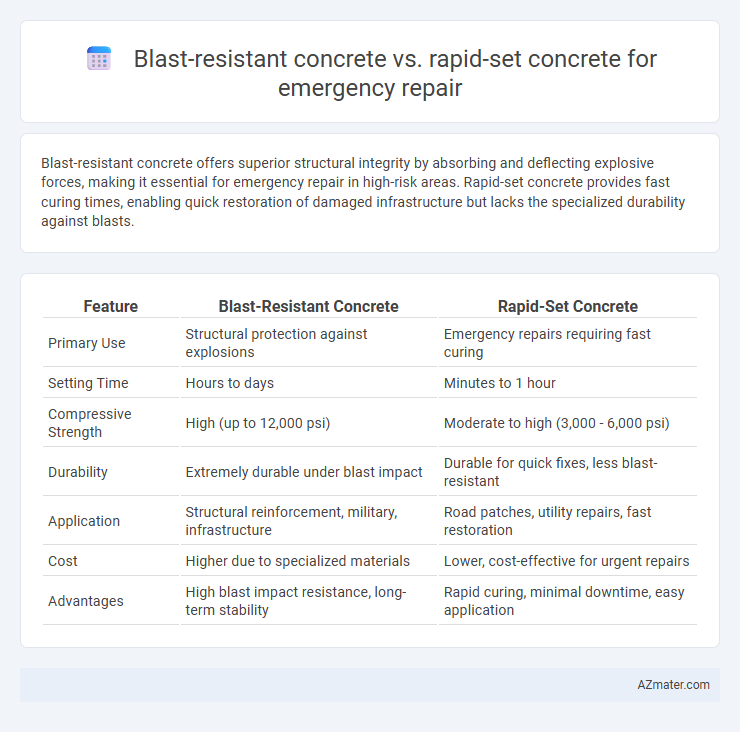Blast-resistant concrete offers superior structural integrity by absorbing and deflecting explosive forces, making it essential for emergency repair in high-risk areas. Rapid-set concrete provides fast curing times, enabling quick restoration of damaged infrastructure but lacks the specialized durability against blasts.
Table of Comparison
| Feature | Blast-Resistant Concrete | Rapid-Set Concrete |
|---|---|---|
| Primary Use | Structural protection against explosions | Emergency repairs requiring fast curing |
| Setting Time | Hours to days | Minutes to 1 hour |
| Compressive Strength | High (up to 12,000 psi) | Moderate to high (3,000 - 6,000 psi) |
| Durability | Extremely durable under blast impact | Durable for quick fixes, less blast-resistant |
| Application | Structural reinforcement, military, infrastructure | Road patches, utility repairs, fast restoration |
| Cost | Higher due to specialized materials | Lower, cost-effective for urgent repairs |
| Advantages | High blast impact resistance, long-term stability | Rapid curing, minimal downtime, easy application |
Introduction to Emergency Concrete Solutions
Emergency concrete solutions prioritize rapid strength development and durability under extreme conditions. Blast-resistant concrete is engineered to withstand high-impact forces and explosive pressures, making it ideal for repairing critical infrastructure exposed to hazardous events. Rapid-set concrete offers accelerated curing times, enabling swift restoration of structural integrity during emergency repairs where time is a crucial factor.
Understanding Blast-Resistant Concrete
Blast-resistant concrete is engineered to withstand high-impact forces from explosions, incorporating dense aggregates and fiber reinforcements to enhance its toughness and energy absorption capacity. This specialized concrete mixture offers superior durability and structural integrity compared to rapid-set concrete, which prioritizes quick curing times but lacks the same level of resistance against blast pressures. Understanding the material properties and performance criteria of blast-resistant concrete is essential for emergency repair scenarios requiring long-term protection against explosive hazards.
Defining Rapid-Set Concrete
Rapid-set concrete is a specialized formulation designed to achieve high early strength, enabling emergency repairs to be completed quickly and restoring structural integrity within hours. Unlike traditional blast-resistant concrete, which is engineered to absorb and dissipate explosive energy for enhanced durability, rapid-set concrete prioritizes fast curing times and rapid load-bearing capacity. Its accelerated setting characteristics make it ideal for urgent repairs on critical infrastructure, minimizing downtime in emergency scenarios.
Key Material Properties Compared
Blast-resistant concrete features enhanced compressive strength, energy absorption, and toughness to withstand explosive forces, making it ideal for emergency repairs in high-risk areas. Rapid-set concrete offers quick setting times, high early strength, and good adhesion, enabling fast restoration of structural integrity during urgent repairs. Comparing the two, blast-resistant concrete prioritizes durability against impacts, while rapid-set concrete emphasizes speed and early load-bearing capacity.
Installation and Curing Times
Blast-resistant concrete offers high durability and impact resistance but typically requires longer curing times, often 7 to 28 days, which can delay emergency repair completion. Rapid-set concrete is engineered for emergency repairs with installation and initial set times as short as 15 to 30 minutes, allowing structures to be returned to service within hours. Choosing between these concretes depends on urgency, with rapid-set solutions favoring quick turnaround and blast-resistant concrete prioritized for long-term durability.
Performance in High-Stress Environments
Blast-resistant concrete offers superior structural integrity and energy absorption in high-stress environments, minimizing damage from explosions and impacts. Rapid-set concrete provides fast curing times essential for emergency repairs but may lack the enhanced durability and toughness required for blast resistance. Choosing between the two depends on balancing immediate repair needs with long-term resilience under extreme stress conditions.
Cost Analysis and Budget Considerations
Blast-resistant concrete typically incurs higher initial costs due to specialized materials and design requirements essential for withstanding explosive forces. Rapid-set concrete offers a more cost-effective solution for emergency repairs, minimizing downtime with faster curing times and reduced labor expenses. Budget considerations should weigh long-term durability and safety benefits of blast-resistant concrete against the immediate cost savings and operational efficiency of rapid-set concrete.
Durability and Longevity Factors
Blast-resistant concrete offers superior durability and longevity due to its enhanced composition that resists high-impact forces and extreme loads, making it ideal for critical structural repairs needing long-term resilience. Rapid-set concrete cures quickly, enabling emergency repairs with fast return-to-service times but may have reduced long-term durability compared to blast-resistant variants, especially under dynamic or high-stress conditions. Selecting between these concretes depends on balancing immediate repair speed against sustained structural integrity and lifespan requirements in emergency contexts.
Best Application Scenarios
Blast-resistant concrete excels in emergency repair scenarios requiring enhanced structural protection against explosions and impact forces, making it ideal for critical infrastructure like military facilities and industrial plants. Rapid-set concrete is best suited for time-sensitive repairs where quick strength gain is necessary to restore functionality, such as airport runways, roadways, and utility repairs. Choosing between the two depends on whether the priority is durability under extreme conditions or fast turnaround time.
Conclusion: Choosing the Right Concrete for Emergency Repair
Blast-resistant concrete offers superior durability and impact absorption necessary for high-risk environments requiring structural safety during emergency repairs. Rapid-set concrete provides the advantage of quick curing times, enabling faster restoration of functionality in urgent repair situations. Selecting between these materials depends on balancing the need for immediate strength recovery with long-term resilience under extreme conditions.

Infographic: Blast-resistant concrete vs Rapid-set concrete for Emergency repair
 azmater.com
azmater.com